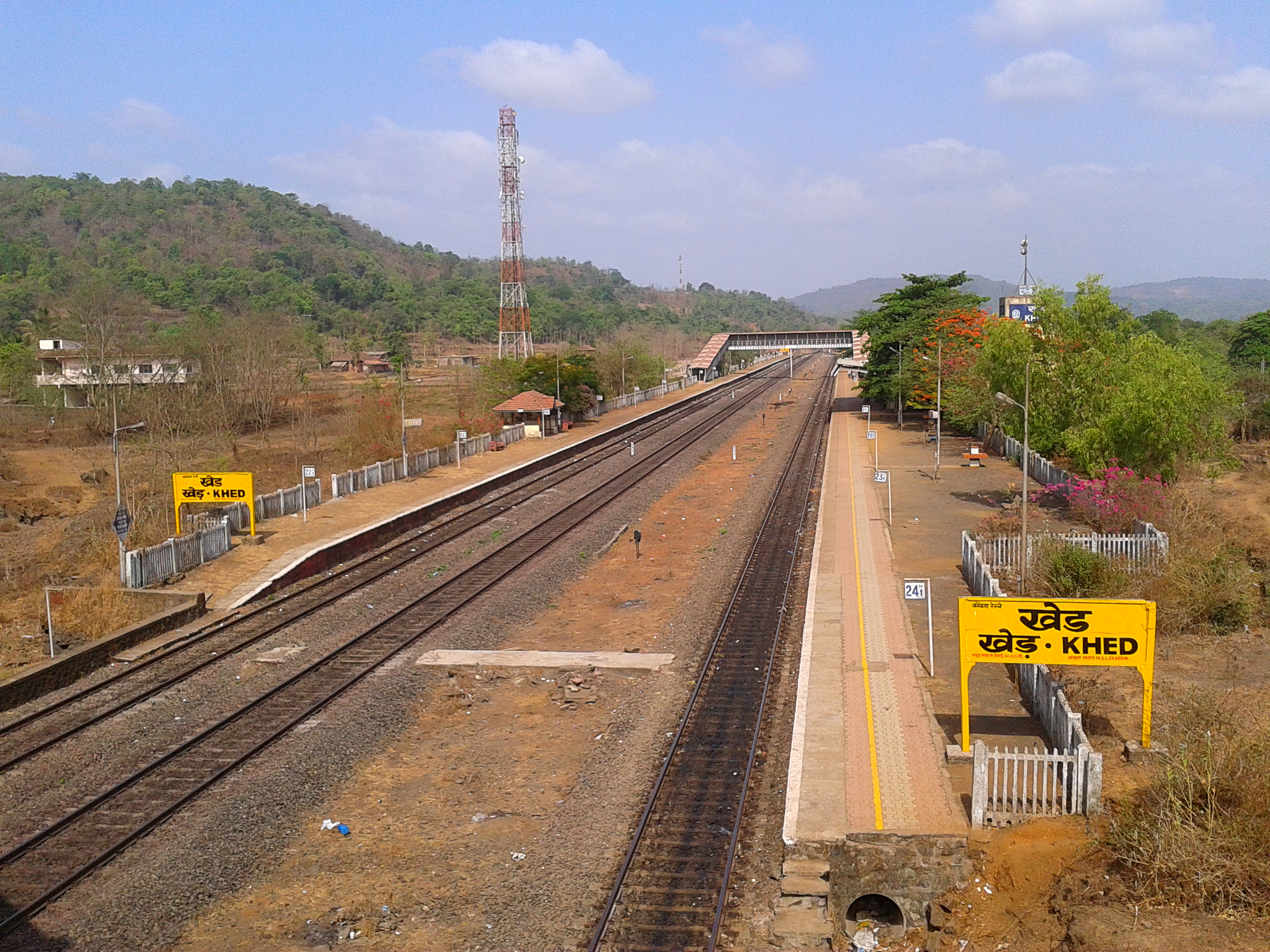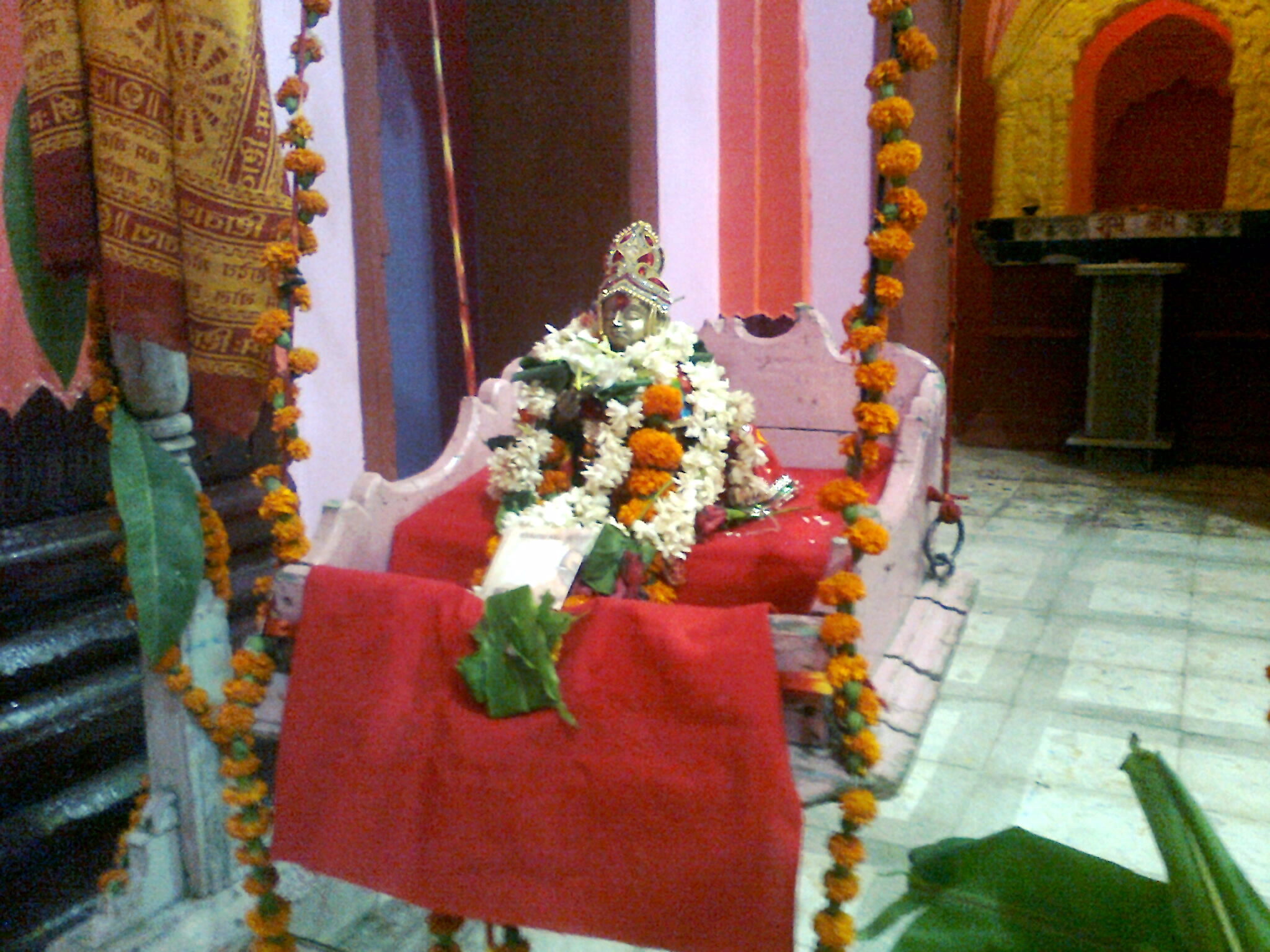|
Khed, Ratnagiri
Khed (Pronunciation: ʰeːɖ is a municipal council in the Ratnagiri district of the state of Maharashtra, India. Khed town is situated on the Mumbai - Ratnagiri Highway. Khed is the headquarters of Khed taluka which connects the district administration with the village administration. Geography Khed is located at . It has an average elevation of 25 metres (82 feet). Alphonso mangoes are grown in the area around the town. Khed lies between Kashedi Ghat and Bhoste Ghat. The region surrounding the town is mostly mountainous. The Jagbudi River is a large river located in the area. Raghuveer ghat is mainly use for picnic spots. Culture Khed is a town that has many festivities. Several religious festivals are celebrated in the town. Social groups like Navnirman Kala Sanstha have been promoting artists from surrounding villages to show their work at state and national levels since 2004. 'RAJ YUVA Mahostav' & 'JCI festival' (mela) is also organized in Khed onc ... [...More Info...] [...Related Items...] OR: [Wikipedia] [Google] [Baidu] |
States And Territories Of India
India is a federal union comprising 28 states and 8 union territories, with a total of 36 entities. The states and union territories are further subdivided into districts and smaller administrative divisions. History Pre-independence The Indian subcontinent has been ruled by many different ethnic groups throughout its history, each instituting their own policies of administrative division in the region. The British Raj mostly retained the administrative structure of the preceding Mughal Empire. India was divided into provinces (also called Presidencies), directly governed by the British, and princely states, which were nominally controlled by a local prince or raja loyal to the British Empire, which held ''de facto'' sovereignty ( suzerainty) over the princely states. 1947–1950 Between 1947 and 1950 the territories of the princely states were politically integrated into the Indian union. Most were merged into existing provinces; others were organised into ... [...More Info...] [...Related Items...] OR: [Wikipedia] [Google] [Baidu] |
Elevation
The elevation of a geographic location is its height above or below a fixed reference point, most commonly a reference geoid, a mathematical model of the Earth's sea level as an equipotential gravitational surface (see Geodetic datum § Vertical datum). The term ''elevation'' is mainly used when referring to points on the Earth's surface, while ''altitude'' or ''geopotential height'' is used for points above the surface, such as an aircraft in flight or a spacecraft in orbit, and '' depth'' is used for points below the surface. Elevation is not to be confused with the distance from the center of the Earth. Due to the equatorial bulge, the summits of Mount Everest and Chimborazo have, respectively, the largest elevation and the largest geocentric distance. Aviation In aviation the term elevation or aerodrome elevation is defined by the ICAO as the highest point of the landing area. It is often measured in feet and can be found in approach charts of the aerodrome. It is n ... [...More Info...] [...Related Items...] OR: [Wikipedia] [Google] [Baidu] |
Pharmaceuticals
A medication (also called medicament, medicine, pharmaceutical drug, medicinal drug or simply drug) is a drug used to diagnose, cure, treat, or prevent disease. Drug therapy (pharmacotherapy) is an important part of the medical field and relies on the science of pharmacology for continual advancement and on pharmacy for appropriate management. Drugs are classified in multiple ways. One of the key divisions is by level of control, which distinguishes prescription drugs (those that a pharmacist dispenses only on the order of a physician, physician assistant, or qualified nurse) from over-the-counter drugs (those that consumers can order for themselves). Another key distinction is between traditional small molecule drugs, usually derived from chemical synthesis, and biopharmaceuticals, which include recombinant proteins, vaccines, blood products used therapeutically (such as IVIG), gene therapy, monoclonal antibodies and cell therapy (for instance, stem cell therapies). ... [...More Info...] [...Related Items...] OR: [Wikipedia] [Google] [Baidu] |
Chemical Industry
The chemical industry comprises the companies that produce industrial chemicals. Central to the modern world economy, it converts raw materials (oil, natural gas, air, water, metals, and minerals) into more than 70,000 different products. The plastics industry contains some overlap, as some chemical companies produce plastics as well as chemicals. Various professionals are involved in the chemical industry including chemical engineers, chemists and lab technicians. History Although chemicals were made and used throughout history, the birth of the heavy chemical industry (production of chemicals in large quantities for a variety of uses) coincided with the beginnings of the Industrial Revolution. Industrial Revolution One of the first chemicals to be produced in large amounts through industrial processes was sulfuric acid. In 1736 pharmacist Joshua Ward developed a process for its production that involved heating saltpeter, allowing the sulfur to oxidize and combine with water ... [...More Info...] [...Related Items...] OR: [Wikipedia] [Google] [Baidu] |
Population
Population typically refers to the number of people in a single area, whether it be a city or town, region, country, continent, or the world. Governments typically quantify the size of the resident population within their jurisdiction using a census, a process of collecting, analysing, compiling, and publishing data regarding a population. Perspectives of various disciplines Social sciences In sociology and population geography, population refers to a group of human beings with some predefined criterion in common, such as location, race, ethnicity, nationality, or religion. Demography is a social science which entails the statistical study of populations. Ecology In ecology, a population is a group of organisms of the same species who inhabit the same particular geographical area and are capable of interbreeding. The area of a sexual population is the area where inter-breeding is possible between any pair within the area and more probable than cross-breeding with in ... [...More Info...] [...Related Items...] OR: [Wikipedia] [Google] [Baidu] |
Census
A census is the procedure of systematically acquiring, recording and calculating information about the members of a given population. This term is used mostly in connection with national population and housing censuses; other common censuses include censuses of agriculture, traditional culture, business, supplies, and traffic censuses. The United Nations (UN) defines the essential features of population and housing censuses as "individual enumeration, universality within a defined territory, simultaneity and defined periodicity", and recommends that population censuses be taken at least every ten years. UN recommendations also cover census topics to be collected, official definitions, classifications and other useful information to co-ordinate international practices. The UN's Food and Agriculture Organization (FAO), in turn, defines the census of agriculture as "a statistical operation for collecting, processing and disseminating data on the structure of agriculture, covering th ... [...More Info...] [...Related Items...] OR: [Wikipedia] [Google] [Baidu] |
Shiv Jayanti
Chhatrapati Shivaji Maharaj Jayanti, also known simply as Shiv Jayanti, is a festival and public holiday of the Indian state of Maharashtra. This festival is celebrated on February 19, celebrating the birth anniversary of Chhatrapati Shivaji Maharaj, the first Chhatrapati and founder of the Maratha Empire. He restablished Hindavi Swarajya indavī Svarājya; "Self-Rule of the hindavi people" Some people celebrate this day as per Hindu Calendar in Maharashtra. : "It was a bid for ''Hindavi Swarajya'' (Indian rule), a term used in Marathi sources of history." History In 1870, Mahatma Phule started celebration of Shivaji Jayanti which was then taken forward by Bal Gangadhar Tilak. Shiv Jayanti is the birth anniversary of great Maratha ruler Shivaji Maharaj. Shivaji Maharaj was born on Marathi Shalivahana Hindu calendar Falgun's Krishna paksha 3, 1551/ Julian February 19, 1630, in Shivneri Fort. The error of not converting the Julian date to the corresponding Gregorian one is still ... [...More Info...] [...Related Items...] OR: [Wikipedia] [Google] [Baidu] |
Gudi Padva
Gudhi Padwa is a spring-time festival that marks the traditional new year for Marathi and Konkani Hindus, but is also celebrated by other Hindus as well. It is celebrated in and around Maharashtra, Goa, Madhya Pradesh and the union territory of Dadra and Nagar Haveli and Daman and Diu on the first day of the Chaitra month, to mark the beginning of the new year according to the lunisolar method of the Hindu calendar. ''Padava'' or ''paadvo'' comes from the Sanskrit word ''pratipada'', which is the first day of a lunar fortnight. The spring festival is observed with colourful floor decorations called ''rangoli'', a special ''Gudhi dvaja'' (a saree or piece of cloth garlanded with flowers, mango and neem leaves, sugar crystal garland called gathi, topped with upturned silver or copper vessels), street processions, dancing, and festive foods. In Maharashtra, first day of the bright phase of the moon is called ''gudhi padwa'' ( mr, गुढी पाडवा), ''pādyo'' ( ... [...More Info...] [...Related Items...] OR: [Wikipedia] [Google] [Baidu] |
Ram Navmi
Rama Navami () is a Hindu festival that celebrates the birthday of Rama, the seventh avatar of the deity Vishnu. people from different parts of Jharkhand attended the world famous international Hazaribagh procession organized in the city every year on the occasion of Ram ramnavmi birt anniversary of Rama amid chants of Jai shri ram. Vaishnava tradition of Hinduism. The festival celebrates the descent of Vishnu as the Rama avatar, through his birth to King Dasharatha and Queen Kausalya in Ayodhya, Kosala. This festival is a part of the Chaitra Navaratri in the spring, and falls on the ninth day of the bright half (Shukla Paksha) of Chaitra, the first month in the Hindu calendar. This typically occurs in the months of March or April by the Gregorian calendar. Rama Navami is an optional holiday for government employees in India.Holiday Calendar ... [...More Info...] [...Related Items...] OR: [Wikipedia] [Google] [Baidu] |
Ganesha
Ganesha ( sa, गणेश, ), also known as Ganapati, Vinayaka, and Pillaiyar, is one of the best-known and most worshipped deities in the Hindu pantheon and is the Supreme God in Ganapatya sect. His image is found throughout India. Hindu denominations worship him regardless of affiliations. Devotion to Ganesha is widely diffused and extends to Jains and Buddhists and includes Nepal, Sri Lanka, Thailand, Indonesia (Java and Bali), Singapore, Malaysia, Philippines, and Bangladesh and in countries with large ethnic Indian populations including Fiji, Guyana, Mauritius, and Trinidad and Tobago. Although Ganesha has many attributes, he is readily identified by his elephant head. He is widely revered, more specifically, as the remover of obstacles and thought to bring good luck; the patron of arts and sciences; and the deva of intellect and wisdom. As the god of beginnings, he is honoured at the start of rites and ceremonies. Ganesha is also invoked as a patron of letters ... [...More Info...] [...Related Items...] OR: [Wikipedia] [Google] [Baidu] |
Ganesh Chaturthi
Ganesh Chaturthi (ISO: ), also known as Vinayak Chaturthi (), or Ganeshotsav () is a Hindu festival commemorating the birth of the Hindu god Ganesha. The festival is marked with the installation of Ganesha's clay idols privately in homes and publicly on elaborate pandals (temporary stages). Observances include chanting of Vedic hymns and Hindu texts, such as prayers and ''vrata'' (fasting). Offerings and ''prasada'' from the daily prayers, that are distributed from the pandal to the community, include sweets such as modaka as it is believed to be a favourite of Ganesha. The festival ends on the tenth day after start, when the idol is carried in a public procession with music and group chanting, then immersed in a nearby body of water such as a river or sea, called visarjan on the day of Anant Chaturdashi. In Mumbai alone, around 150,000 statues are immersed annually. Thereafter the clay idol dissolves and Ganesha is believed to return to his celestial abode. [...More Info...] [...Related Items...] OR: [Wikipedia] [Google] [Baidu] |








